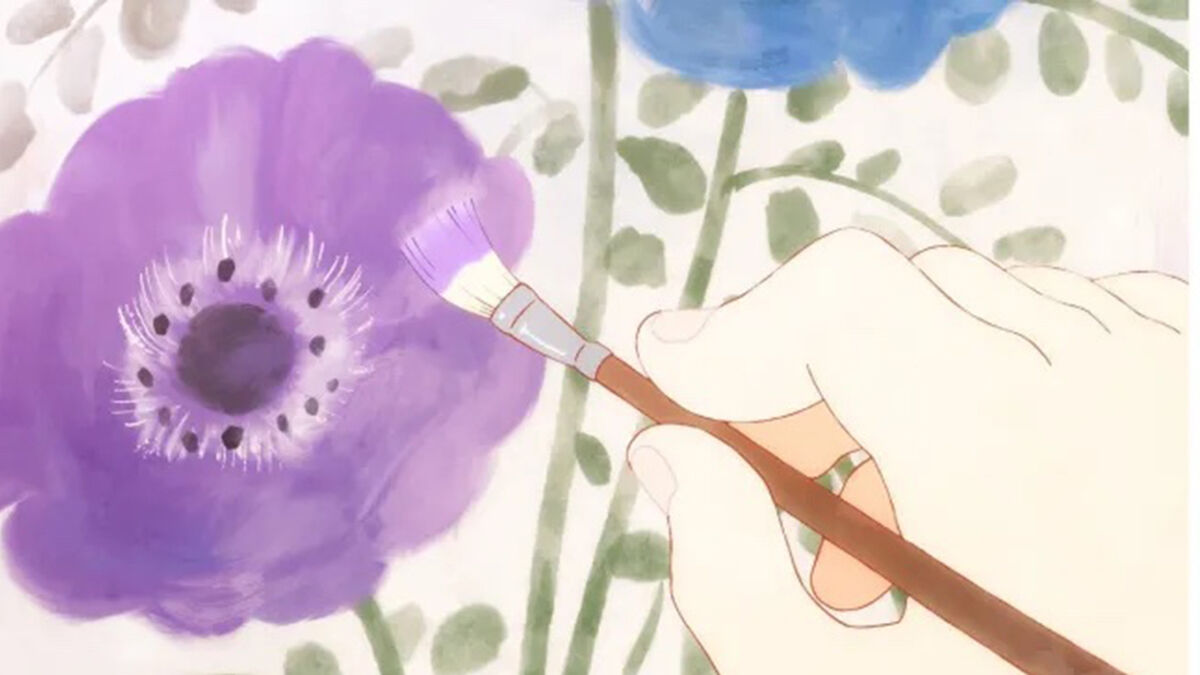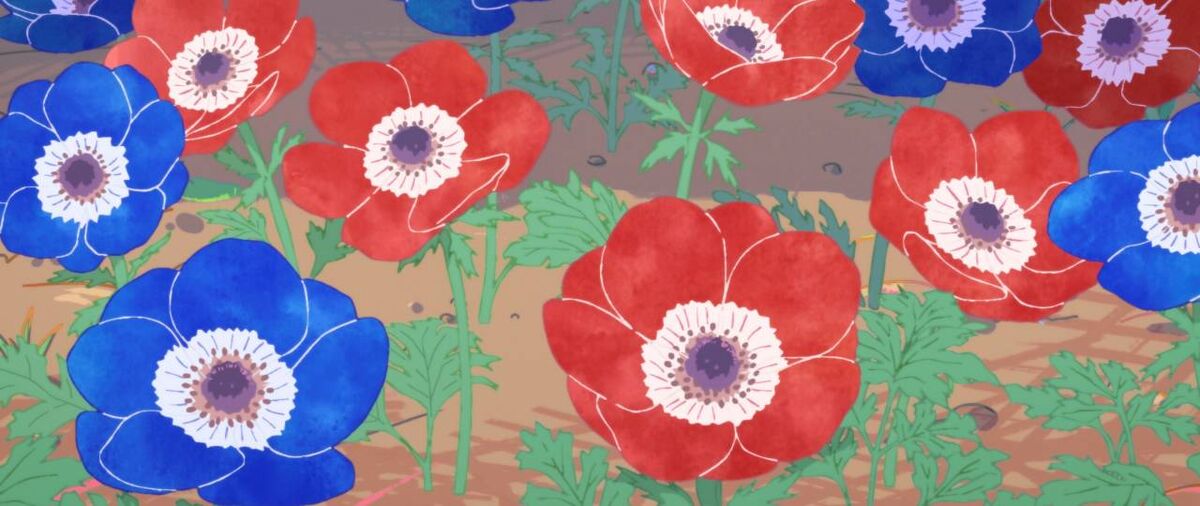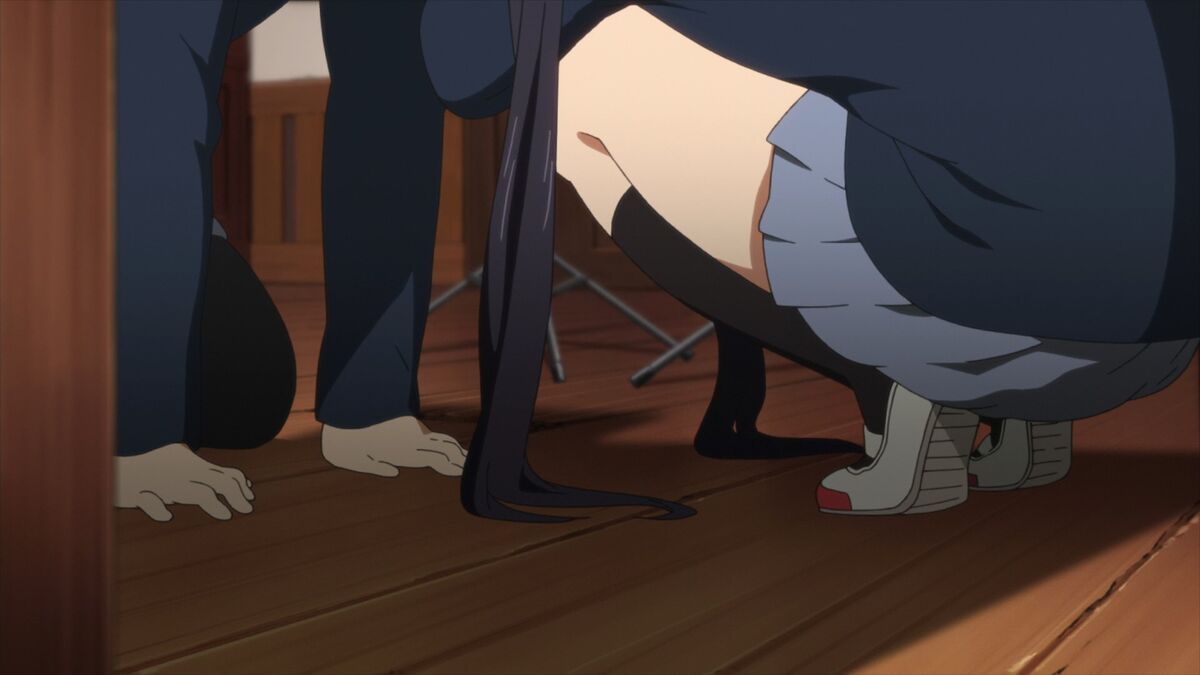Celebrated anime director Naoko Yamada’s latest project is a beautiful study of death. Or perhaps, more accurately, grief.
The director is known for her work with Kyoto Animation studio, particularly slice-of-life comedy anime series K-On!, manga adaptation A Silent Voice, and a number of Sound! Euphonium works. More recently, Yamada directed The Heike Story, a series she made with Science SARU, the animation studio behind the recent Inu-Oh.
Her new short film, also made with Science SARU, is called Garden of Remembrance. It’s profoundly evocative. Its focus on the everyday, its pastel colour palette, moving music, and deceptive simplicity all give it an extraordinary power. It captures a series of complex feelings that arise out of losing a loved one, and feels deeply personal at the same time as conveying a sense of the universal. Grief touches everyone, and can make us feel isolated and alone, and yet life goes on.
Swirling patterns in a cup of coffee or flowers signify the spiral of grief, but also the idea that the world keeps turning. Daily rituals can make us feel like we’re imprisoned but also bring comfort, and it’s through the repetitive nature of getting up every day that the main protagonist in Yamada’s film – and by extension, we — start to heal. Small variations in ritual and routine signpost incremental change; a shift in feeling; a sense that she, and we, must and will continue onwards. An absence of dialogue deepens the complexity of what we feel when we watch.

“Initially, when this project began, the starting point was that it was meant to be a collaboration between music and animation,” begins Yamada, who is talking to Fandom ahead of her film’s world premiere at the Scotland Loves Anime film festival. “We focused on what the animation could portray as well as what the music could give to this project. So there was no need for dialogue to begin with. But if we were to dig deeper I think what I felt was [that] dialogue could sometimes limit the interpretation and also what could be portrayed within animation as well. Because it forces one understanding to the audience, whereas by removing the dialogue, you could really open up different ways of interpreting the creation. I think that was something that I wanted to explore in this work.”
Yamada is known for treating all her characters as if they are real individuals. In Garden of Remembrance, this is especially powerful with the main protagonist because her idiosyncrasies actually help us, yes, to sympathise, but also deeply empathise. Even if we don’t share the character’s precise characteristics or behaviours, we are encouraged to identify our own and think about the small moments that we share and perhaps have taken for granted with a loved one. But how does Yamada manage to put herself so successfully into the minds of her characters and convey that on screen?
“It’s a difficult one to answer,” says Yamada. “In order to go into the character’s mindset, there are many elements — part of me goes into the characters’ perspectives. But also there is another part of me that is objectively looking at that character almost like a camera person as well. And even when I am going into the character’s mindset, there isn’t really my emotion that is experiencing what the characters are going through.
“There are a few different layers in terms of characters’ perspectives, but, fundamentally, I am very much interested in what human beings experience in terms of emotions and what they go through. And also I am always in awe of anybody who can express their emotions quite freely. Those who are quite expressive and open. I always wanted to be very respectful and mindful when I depict what the characters go through. And I also have a policy that I don’t create something just for myself. The emotions aren’t for myself personally. I’m more of an observer of what is happening.”

With Garden of Remembrance, Yamada wanted to depict those feelings of care or love that we might have for someone and where they might be directed if the feelings are one-sided. In the case of a loved one dying, those feelings become one-sided.
“So when it’s one-sided, where does it go?” says Yamada. “I just really wanted to respect those feelings of the care that we have for each other and what human beings feel towards another human being. I really wanted to portray that in a very practical, realistic manner.”
She continues, “I heard a story relating to the afterlife. In regards to the care that we have for somebody, if somebody died, and if what remained was their soul, and if they went to such a thing as heaven, I have heard that if we think of those who have deceased, our feelings would become a flower and would be sent over to heaven. Somebody told me that and I thought, ‘Wow, what a beautiful description and what a beautiful thing to think about.’ That was something that inspired me.”
You’ll notice as you watch the film that the colour palette Yamada uses is primarily made up of washed-out shades and pastels. There’s a sense of a faded vibrancy that we might associate with the idea of the hole left by the loss of a loved one, and certainly later in the film, there are red and blue flowers that are bolder than the hues of the rest of the film and which seem to directly represent the protagonist’s lost love. But the colour choice also represents a deliberate attempt on Yamada’s part to counteract the darkness of the theme her film explores.
“Because the theme that I was exploring is somewhat serious — centered around death — I wanted to make it more of a happy scene, the look of it, for the audience. Almost to balance out what [the film deals with],” says Yamada. “It’s almost like a vaccine for dealing with something that is serious in what was being depicted. I wanted that contrast between the pastel colours and the theme.”

Yamada is always really thoughtful about the way she approaches her work and presents it to the audience. She is drawn to the sensibilities and practices of live-action cinema, appropriating them for her work in animation. This goes for the way she frames characters, plays with camera angles, and more. In the past, she’s said she likes to focus on characters’ legs – not in the way that, say, Quentin Tarantino loves feet – but because we move our legs when we’re nervous. It’s an authentic, well-observed way of depicting emotion.
We see this in Garden of Remembrance, but it also characterises her other work. Yamada’s rich vein of work has rightly won her an army of fans. So, we did the sensible thing and went to Fandom’s anime community to gather questions from some of those fans to put to her.
JC The Beard#1240, wondering how her work has changed, wants to know how working at Science SARU on this and previous project The Heike Story compares to her experiences at Kyoto Animation.
“It might be on the surface level, but the biggest difference for me was the tools that I used to create the animation,” says Yamada. “Because when I was at Kyoto Animation, everything was done with pen and paper; and pencil and paper. But Science SARU is almost one hundred percent digital, so after I started collaborating with Science SARU, I studied digital animation. So that was the big difference for me.”
One franchise she would return to multiple times while at Kyoto Animation was Sound! Euphonium. Yamada has worked on both the series, and associated films. JC The Beard#1240 also wanted to know what Yamada’s favourite scene or shot from all of the Sound! Euphonium work she did is, and what makes it special to her?
She picks an entire work rather than a specific scene: “It’s the work that I directed, the spin-off. Liz and Blue Bird is probably my favourite. It’s something that I cherish quite a lot.”
And, asks Mace/wcfb75#1653, which Sound! Euphonium character does she relate to the most?
“This relates to your previous question,” begins Yamada. “It wasn’t so much about who I related to the most, it was really [more that] every one of the characters I was impressed by — their behaviors and also what they said. Whenever they did something or said something I was like, ‘Oh, okay, I didn’t realize that that was the perspective that you had’ or like, ‘No, this was the way of thinking’ so I learned a lot by observing. It was just refreshing to go through and just see what they needed to say.”
Early in her career, Yamada worked on the series K-On!, about a high-school rock band. Mashi #ShikiSweep/Mashi#8176 asks which episode of the series she enjoyed directing the most.
“It’s the first episode really,” says Yamada. “It’s because I was very excited to create the story with those characters for the first time; to depict their world. I remember being so excited. Just excitement bubbling up inside me. So yes, the first episode definitely.”
And then what was her favourite thing about working on K-On! The Movie, asks Indigo Drift #HirasawaSupremacy/Indigo Drift#1340.
Yamada says, “It just was great to be able to come to London for that film and for the characters to experience London themselves as well.”
Some fans, like Yoshix/FCDA#0466, are keen to see Yamada make a return to the kind of comedic slice-of-life genre of K-On! and her 2013 series Tamako Market, about the life of a high-school student whose parents run a mochi shop. Is this a genre she might return to in the future?
Yamada says, “Absolutely. There is definitely bountiful possibilities because I really like that genre as well.”
Good news for Yoshix/FCDA#0466 and everyone else who loves Yamada’s earlier work. Which begs the question, what’s been the most challenging project she’s worked on in her career? A question posed by Yogurt of the Yoshi/donial#0986.
“Every one of my projects has been challenging really,” admits Yamada. “Because I always feel like I’m starting from zero and then building something up. So always it’s a challenge to think and really decide what I will do. It’s a constant challenge. It’s difficult to pick one. It’s just an ongoing process.”
So how does it feel when a project is finally out there in the wild?
“It’s interesting because once the project is completed, once the films are done, my soul just gets detached from that work,” explains Yamada. “Love remains always for the creations, but it doesn’t feel like I am attached to what is, and what has happened; what has been done. So once it’s completed, it’s out there, it’s separate from me, but I always love what was created.”
Is there a manga, novel, or story that she would like to adapt if she got the chance, asks BurgahBoy#3510.
“If I were to name something, it would be Beneath the Wheel by Hermann Hesse. He’s a German writer,” says Yamada. “I think that would create a very beautiful animation.”
The 1906 novel is far from a comedy, but it does focus on a child of school age – a gifted boy sent to a boarding school where academic excellence is the focus at the expense of personal development. His performance starts to decline with the onset of symptoms of mental illness, and he is sent home, after which he finds it difficult to adjust.
It’s not difficult to envision this story in anime form but no doubt in Naoko Yamada’s hands, it will become something personal, unique, and, needless to say, compelling. Let’s hope she gets to make her dream project sooner rather than later.
Check out our interview with the co-founder of Science SARU, Masaaki Yuasa, director of the studio’s bold and unforgettable recent release Inu-Oh, below.
Related